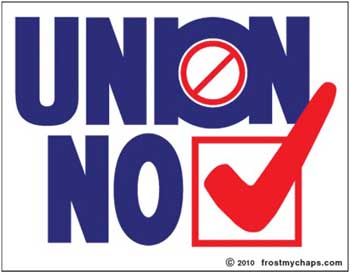
In honor of the Labor Day holiday, Gallup is out with its regular survey assessing the public’s attitude about labor unions. Gallup’s headline is that approval of labor unions is steady at 52%. This is true, if by steady you mean that unions continue to have the lowest approval rating since the question was first asked in the 1930s.
Just four years ago, 60% of the public approved of labor unions, while 31% disapproved. Today, 42% disapprove of unions, a move of 11 points in a very short period of time. In the 70+ years Gallup has been asking the question, approval has generally been in the 60s and disapproval in the 20s. Support for unions peaked in the 1950s, when 75% of the public approved of unions.
And, this isn’t some kind of skew from question wording. Here’s the question Gallup asks:
Do you approve or disapprove of labor unions?
Now, I do have certain existential problems with unions, but I’m not certain I would disapprove of them 100% of the time in all situations. I mean, that question is a pretty clear up-or-down choice. That only around half of adults approve of unions today is a stark reminder of how far labor unions have fallen.
Worse for unions, however, is that a plurality of Americans, 41%, think unions should have less influence. 25% think they should have about the same amount of influence and 29% think unions should have more influence. Four years ago, these numbers were basically reversed, with 35% wanting unions to have more influence and 32% less influence.
I think two things account for labor’s approval drop; the recession and the growing fight over public sector wages and benefits. At their most basic level, unions are a job cartel making union membership a requirement for many jobs in large parts of the country. With so many Americans unable to find work for the past four years, there is bound to be growing resentment towards unions.
But, the second reason should worry union bosses. A majority of union members now are public sector employees. As state and local governments struggle with very tight budgets, the wages and benefits of public sector employees are becoming enormous issues in the debate over government spending. It will be next to impossible to get spending under control unless the expensive benefit packages are curtailed.
To many Americans, though, it isn’t so much a math problem as a question of fairness. In most cases, public sector union members pay very little for health and pension benefits that a private sector worker could only dream about. These benefits are paid for with taxes from the private sector worker, who herself often has to struggle to afford health insurance and save for retirement.
The whole situation is unsustainable and, until it is addressed, expect public support for labor unions continue to decline.

COMMENTS
Please let us know if you're having issues with commenting.